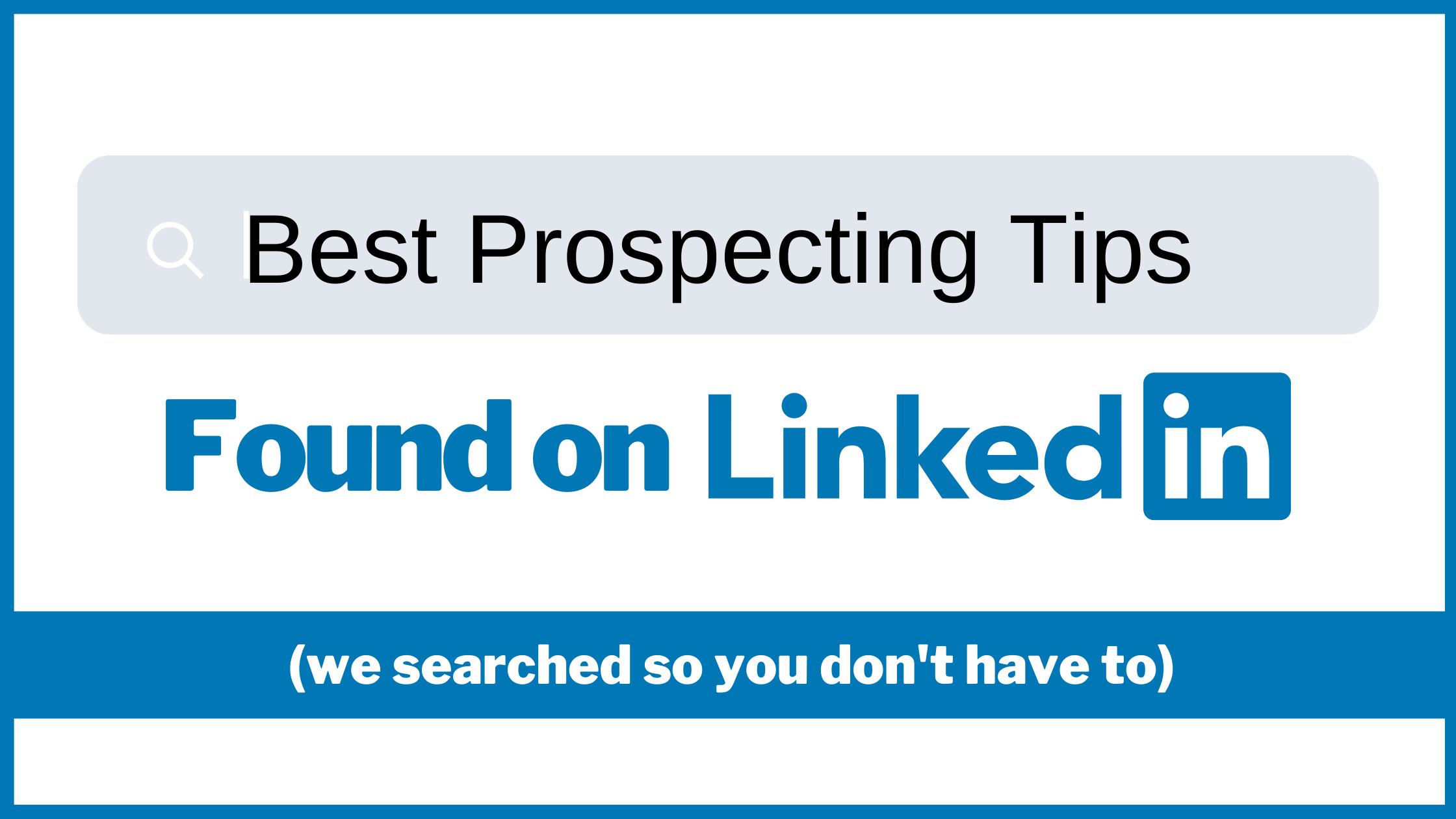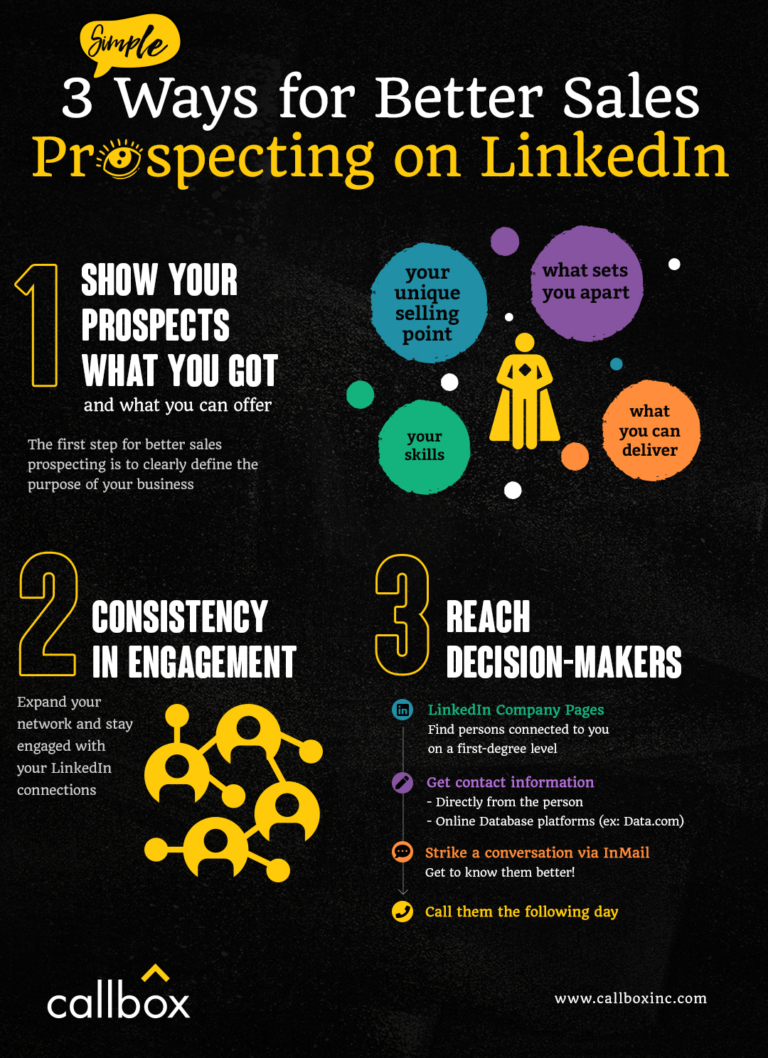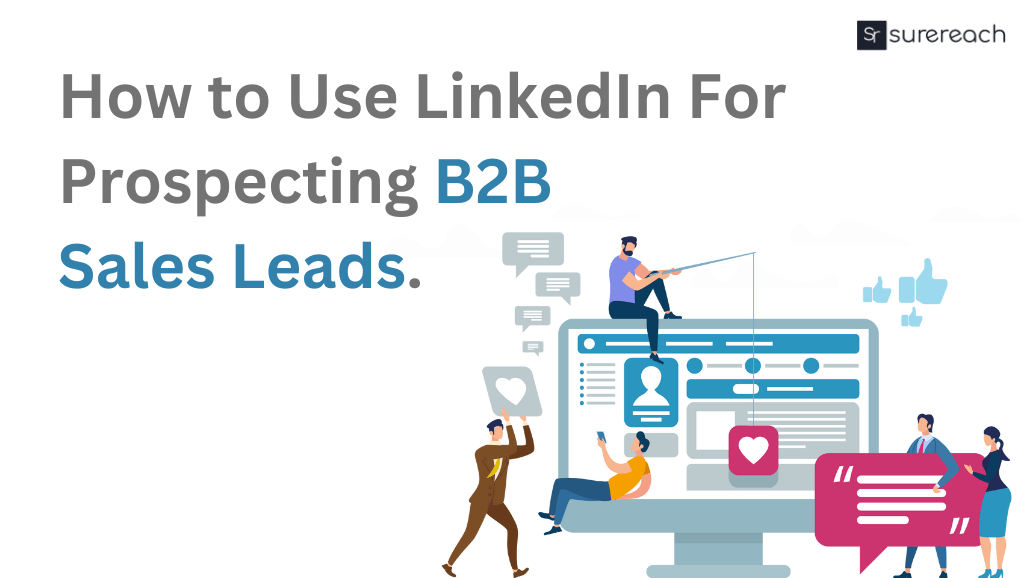In today’s digital age, finding the right leads for your sales pipeline can feel like searching for a needle in a haystack. Luckily, LinkedIn makes this process a whole lot easier! This professional network isn't just for job seekers; it’s a treasure trove for sales professionals looking to connect with decision-makers, build relationships, and ultimately drive sales. In this post, we’ll explore how to effectively use LinkedIn for sales prospecting and why it’s become an essential tool for professionals in the industry. Let’s dive in!
Why LinkedIn is a Powerful Tool for Sales Professionals

LinkedIn is often referred to as the world's largest professional network, boasting over 700 million users worldwide. This immense platform offers countless opportunities for sales professionals, and here's why:
- Targeted Audience: LinkedIn allows you to precisely target your audience based on demographics, job titles, industries, and even companies. This means you can tailor your outreach to the right people who are most likely to benefit from your product or service.
- Relationship Building: Instead of cold calling, which can often feel intrusive, LinkedIn encourages relationship building. By engaging with potential leads through comments, messages, and shared content, you create a rapport before even discussing a sale.
- Research Opportunities: The platform enables you to research prospective clients thoroughly. You can check their backgrounds, understand their professional interests, and even see the content they share. This information lets you personalize your approach significantly.
- Content Sharing: By sharing valuable content related to your industry or expertise, you position yourself as a thought leader. This not only attracts potential prospects but also builds credibility and trust. When it’s time to sell, they’ll already have a sense of who you are and what you can offer.
- Referrals and Recommendations: Networking is key in sales, and LinkedIn shines in this area. After you’ve established a connection, asking for referrals or recommendations becomes much more natural. A warm introduction from a mutual connection can be the difference between getting a foot in the door or being ignored.
That said, using LinkedIn effectively requires a strategy. Here are a few quick tips to maximize its potential:
- Optimize Your Profile: Make sure your LinkedIn profile is complete and highlights your expertise. A professional photo, a strong headline, and a compelling summary can make a great first impression.
- Engage Consistently: Regularly engage with content from your connections. This can include liking, commenting, or sharing their posts, which helps keep you on their radar.
- Utilize LinkedIn Sales Navigator: If you’re serious about prospecting, consider investing in LinkedIn Sales Navigator for advanced lead recommendations and insights.
In conclusion, LinkedIn isn’t just a job search engine; it’s a powerhouse for sales prospecting. By utilizing its features effectively, you can connect with high-quality leads, build lasting relationships, and ultimately, boost your sales success. Embrace the platform, and watch your sales efforts transform!
Also Read This: Can LinkedIn Premium Users See Anonymous Viewers? What to Know About Privacy
3. Creating an Optimized LinkedIn Profile for Sales Success

When it comes to using LinkedIn for sales prospecting, your profile is your first impression. Think of it as your digital business card—only much more dynamic! An optimized profile not only highlights your skills and experience but also makes you more approachable and trustworthy to potential clients. So, how can you create a profile that stands out? Let’s dive into some essential tips.
Step 1: Professional Profile Photo
Your profile picture is crucial. Choose a clear, professional image where you look approachable. A smile can make a world of difference here! Profiles with photos get 21 times more profile views and 36 times more messages, according to LinkedIn.
Step 2: Eye-Catching Headline
Your headline should succinctly convey who you are and what you do. Instead of just your job title, consider including keywords relevant to your target audience. For example, rather than just “Sales Manager,” try “Results-Driven Sales Manager Helping Tech Companies Boost Revenue.” This approach clearly defines what you do and who you help.
Step 3: Customized Summary
Your summary is your opportunity to tell your story. Be authentic! Share your professional journey, what drives you, and how you can help potential clients solve their problems. Aim for a conversational tone. You want to engage visitors to your profile.
Step 4: Showcase Your Skills and Endorsements
- Key Skills: List skills that are crucial for your target market. Use the skills section to highlight what you excel at.
- Endorsements: Encourage colleagues and clients to endorse your skills. This builds credibility and helps prospective clients trust you.
Step 5: Gather Recommendations
Recommendations function as social proof, helping build your authority in your field. Reach out to satisfied clients or colleagues and ask them to write a few sentences about your work together. Genuine testimonials can significantly enhance your profile's attractiveness.
Step 6: Add Relevant Content
Consider sharing articles, blog posts, or other content that demonstrates your expertise in your industry. This not only showcases your knowledge but also keeps your profile fresh and relevant. Plus, engaging content may capture the attention of prospects browsing your profile.
Remember, your LinkedIn profile is not just a resume but a marketing tool. A well-optimized profile can significantly improve your chances of connecting with potential clients and closing deals. So, take the time to refine and update your LinkedIn presence!
Also Read This: How to Create a Hyperlink in a LinkedIn Post for Easy Click-Through
4. Strategies for Finding and Connecting with Prospects

Once your LinkedIn profile is optimized, the real fun begins—finding and connecting with prospects! Whether you’re a seasoned sales pro or just starting, these strategies will help you effectively reach out and build meaningful connections.
Strategy 1: Use LinkedIn’s Advanced Search
LinkedIn’s search functionality is a powerful tool. By utilizing the advanced search feature, you can filter results by industry, location, company size, and more. Here’s how you can refine your search:
- Specific Titles: Enter titles relevant to the decision-makers you want to reach.
- Keywords: Include traits or skills relevant to your product or service.
- Geography: Narrow down your search to specific regions or cities.
Strategy 2: Join Relevant Groups
Joining LinkedIn groups related to your industry is a fantastic strategy to connect with prospects. Participate by sharing valuable insights, starting discussions, or simply engaging with posts. This builds rapport and establishes your presence in the community.
Strategy 3: Leverage Mutual Connections
If you find someone you’d like to connect with but don’t know them personally, check for mutual connections. A warm introduction is much more effective than a cold outreach. Reach out to your mutual contact and ask if they’d be willing to introduce you.
Strategy 4: Personalized Connection Requests
When sending connection requests, always customize your message! Mention how you found their profile and why you’d like to connect. Personalization shows that you’ve taken the time to learn about them, making it more likely they’ll accept your request.
Strategy 5: Share Valuable Content and Insights
Position yourself as a thought leader by sharing relevant industry content and insights. This not only engages your existing connections but can also attract potential prospects to your profile. Consistency is key—aim to post regularly and keep the content relevant.
Utilizing these strategies can significantly enhance your ability to find and connect with potential clients on LinkedIn. Remember, it’s about building relationships, not just making sales pitches. By taking the time to connect and engage authentically, you pave the way for valuable business opportunities!
Also Read This: How Much Does a LinkedIn Ad Cost? A Guide to LinkedIn Advertising Costs
5. Engaging with Prospective Clients on LinkedIn
When it comes to sales prospecting on LinkedIn, engagement is key. You don’t want to just send a connection request and then disappear into the void. Instead, think of LinkedIn as a platform to build relationships. Here are some effective strategies to keep in mind:
- Personalize Your Outreach: Instead of using generic messages, take a moment to personalize your connection requests. Mention something specific about their profile or a shared interest. This shows that you’re genuinely interested.
- Comment on Their Posts: Engaging with content your prospects share is an excellent way to get noticed. When you leave thoughtful comments on their posts, it not only shows that you value their insights but also keeps you on their radar.
- Send Follow-Up Messages: Once your connection request is accepted, don’t hesitate to follow up with a thank you message. You can also share resources that may be valuable to them, such as articles or reports related to their industry.
Remember, the goal here is to start a conversation, not to make an immediate sale. Here’s a quick framework for how you might structure your initial outreach:
| Step | What to Do |
|---|---|
| 1 | Send a personalized connection request. |
| 2 | Engage with their posts regularly. |
| 3 | Send a thank you message after they accept your request. |
| 4 | Share valuable resources tailored to their interests. |
| 5 | Initiate meaningful conversations based on common interests. |
The key here is to be genuine and patient. Building relationships takes time, but the benefits far exceed the immediate gratification of a sale. With consistent engagement, you position yourself as a helpful resource and trusted advisor in your prospects' eyes.
Also Read This: How to Edit a Scheduled Post on LinkedIn Without Losing Engagement
6. Leveraging LinkedIn Groups for Networking and Prospecting
One often overlooked feature of LinkedIn is its groups, which can be a goldmine for networking and prospecting. Joining groups relevant to your industry or target audience can open up new avenues for connection and conversation. Here’s how to make the most of it:
- Identify Relevant Groups: Start by searching for groups that align with your target market. Use keywords related to your industry, services, or sectors you want to engage with. Spend some time browsing the group descriptions to find those that are active and have engaged members.
- Participate Actively: Once you’ve joined groups, don’t just be a passive observer. Share insightful content, answer questions, or start discussions. Being active not only establishes your expertise but also makes you more visible to potential leads.
- Network with Group Members: Take the time to connect with individuals who stand out in the discussions. When sending connection requests, reference your shared group to provide context. This connection strategy can yield a higher acceptance rate.
- Avoid Spamming: While it may be tempting to promote your services, resist the urge to spam the group with sales pitches. Instead, focus on providing value. Building reputations as a knowledgeable contributor can lead to warm referrals down the line.
Here’s a practical plan for utilizing LinkedIn groups for prospecting:
| Step | Action |
|---|---|
| 1 | Find 2-3 relevant LinkedIn groups. |
| 2 | Join discussions by commenting and asking questions. |
| 3 | Share valuable content and insights in the group. |
| 4 | Connect with members who engage with your posts. |
| 5 | Follow up with meaningful conversations outside of the group. |
Using LinkedIn groups effectively can lead to strong connections that may turn into opportunities. Dive in, participate, and watch your network grow!
Also Read This: How to Announce an Internship on LinkedIn with Professional Impact
7. Utilizing LinkedIn Sales Navigator for Targeted Prospecting
If you're serious about leveraging LinkedIn for sales prospecting, you simply can't overlook the power of LinkedIn Sales Navigator. This premium tool transforms how you find and connect with potential clients, allowing for an incredibly targeted approach. Think of it as your secret weapon in a crowded sales landscape!
So, what makes Sales Navigator so special? Here are some standout features:
- Advanced Search Filters: Tailor your prospecting efforts by using filters like location, company size, industry, and even seniority level. This allows you to pinpoint exactly who you want to reach out to and tailor your message accordingly.
- Lead Recommendations: The platform uses algorithms to suggest leads that match your sales preferences, which can save you tons of time when searching for new prospects.
- CRM Integration: If you're already using a CRM system, Sales Navigator can seamlessly integrate to keep all your data in one place. This makes tracking interactions and managing leads much easier.
- InMail Messages: Use InMail to reach out directly to prospects outside your connections. This can be a game-changer for initiating conversations with key decision-makers.
But, how do you make the most of these features? Here are a few practical tips:
- Define Your Ideal Customer Profile: Spend time creating a detailed profile of your ideal prospect. What companies do they work for? What roles do they hold? This will guide your search.
- Save Leads and Accounts: As you find prospects that fit your profile, save them to organize your outreach efforts effectively. This way, you have a focused list to work from.
- Engage with Content: Before reaching out, interact with your prospects’ posts. Comment, like, or share what resonates with you. This provides a level of familiarity when you send your InMail.
Remember, prospecting isn't just about sending a flurry of messages; it’s about building relationships. The more you utilize the specific capabilities of LinkedIn Sales Navigator, the more refined your approach becomes, leading to higher chances of converting leads into valuable clients.
Also Read This: How to Download Your LinkedIn Connections List for Better Management
8. Measuring Success in LinkedIn Sales Prospecting
Now that you've implemented LinkedIn for your sales prospecting efforts and possibly invested in tools like Sales Navigator, the next crucial step is measuring your success. After all, how will you know if your efforts are paying off unless you track your results?
Here are some key metrics to keep an eye on:
- Connection Requests Sent vs. Accepted: Track the number of connection requests you send versus how many are accepted. A low acceptance rate might indicate that your message needs refinement.
- InMail Response Rate: If you’re using InMail, monitor the response rates to understand how compelling your outreach messages are. A low response may require you to tweak your messaging strategy.
- Engagement Rates: This includes likes, comments, and shares on your posts and articles. High engagement can be a good indicator that you’re connecting with your audience meaningfully.
- Conversions: Ultimately, the goal is to convert prospects into clients. Track how many of your leads are turning into sales and assess the quality of those conversions.
To effectively measure your success, consider setting up a simple tracking system using spreadsheets or customer relationship management (CRM) software. Here are a few practices to ensure you’re on the right track:
- Set Clear Goals: Determine what success looks like for you. Is it a specific number of leads per month? Define it clearly.
- Analyze and Adjust: Regularly review your metrics to determine what's working and what isn't. Don’t hesitate to make adjustments based on your findings.
- Solicit Feedback: If you're connecting with prospects, consider asking for feedback on your approach. This can provide insights that improve your strategy.
Measuring success in your LinkedIn prospecting efforts isn't just about numbers; it's about understanding your audience, refining your approach, and ultimately driving those conversions. With the right metrics and a willingness to adapt, your LinkedIn strategy can become a highly effective cornerstone of your sales efforts!
Conclusion and Next Steps for Sales Professionals
In today's competitive landscape, leveraging LinkedIn for effective sales prospecting is more crucial than ever. As you've learned throughout this post, maintaining a strong presence on LinkedIn offers numerous opportunities to connect with potential clients and nurture professional relationships.
To summarize the key takeaways:
- Optimize your profile: Ensure your LinkedIn profile is polished and professional, showcasing your expertise and value proposition.
- Engage with content: Regularly share insightful content to position yourself as a thought leader in your industry.
- Utilize advanced search: Use LinkedIn's search features to identify and connect with your target market efficiently.
- Personalize outreach: Tailor your connection requests and messages to resonate with your prospects and foster meaningful conversations.
- Follow up strategically: Keep the momentum going with follow-ups that add value without overwhelming your prospects.
As you move forward, consider establishing a routine to incorporate these strategies into your daily sales activities. Dedicate time each week to:
| Action | Frequency |
|---|---|
| Profile Updates | Monthly |
| Content Sharing | Weekly |
| Networking Outreach | Daily |
| Follow-Up Messages | As Needed |
In conclusion, by consistently applying these LinkedIn sales prospecting strategies, you’ll enhance your ability to connect with prospects and ultimately drive your sales success. Start taking these actionable steps today, and watch your professional network and opportunities grow!
 admin
admin








